Ohio State University
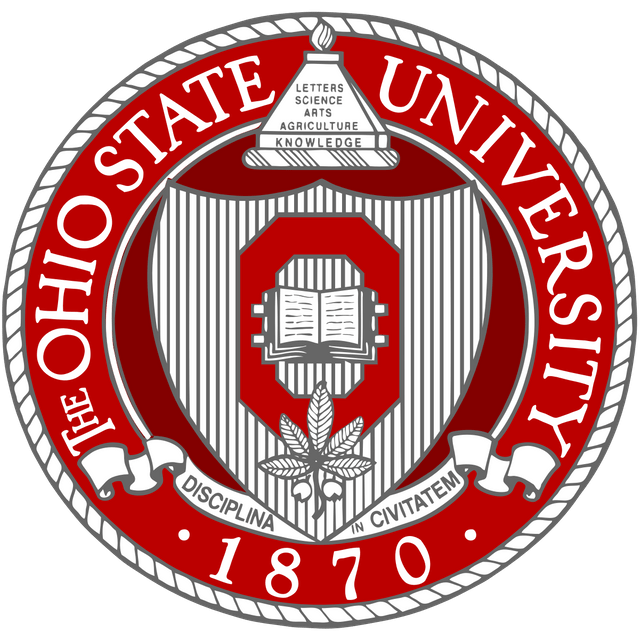
Ohio State University

| Motto | Disciplina in civitatem (Latin) |
|---|---|
Motto in English | Education for Citizenship |
| Type | Flagship Public Land grant Sea grant Space grant |
| Established | 1870 |
Academic affiliations | AAU APLU BTAA ORAU University System of Ohio |
| Endowment | $5.2 billion (2018)[1] |
| President | Michael V. Drake, M.D. |
Academic staff | 7,310[2] |
Administrative staff | 27,158[2] |
| Students | 61,170 (Columbus) 68,100 (all campuses)[2] |
| Undergraduates | 46,820 (Columbus) 53,734 (all campuses)[2] |
| Postgraduates | 14,350 (Columbus) 14,366 (all campuses)[2] |
| Location | Columbus ,,United States |
| Campus | 1,665 acres (7 km2) Columbus campus 16,196 acres (66 km2) total[2] |
| Colors | Scarlet and Gray[3] |
| Nickname | Buckeyes |
Sporting affiliations | NCAA Division I Big Ten Conference |
| Mascot | Brutus Buckeye |
| Website | osu.edu [104] |
| University rankings | |
| National | |
| ARWU[12] | 45 |
| Forbes[13] | 121 |
| Times/WSJ[14] | 94 |
| U.S. News & World Report[15] | 56 |
| Washington Monthly[16] | 95 |
| Global | |
| ARWU[17] | 100 |
| QS[18] | 101 |
| Times[19] | 70 |
| U.S. News & World Report[20] | 46 |
The Ohio State University (OSU), commonly referred to as Ohio State, is a large public research university in Columbus, Ohio. Founded in 1870 as a land-grant university and the ninth university in Ohio with the Morrill Act of 1862,[4] the university was originally known as the Ohio Agricultural and Mechanical College. The college originally focused on various agricultural and mechanical disciplines but it developed into a comprehensive university under the direction of then-Governor (later, U.S. President) Rutherford B. Hayes, and in 1878 the Ohio General Assembly passed a law changing the name to "The Ohio State University".[5] The main campus in Columbus, Ohio, has since grown into the third-largest university campus in the United States.[6] The university also operates regional campuses in Lima, Mansfield, Marion, Newark, and Wooster.
The university has an extensive student life program, with over 1,000 student organizations; intercollegiate, club and recreational sports programs; student media organizations and publications, fraternities and sororities; and three student governments. Ohio State athletic teams compete in Division I of the NCAA and are known as the Ohio State Buckeyes. As of the 2016 Summer Olympics, athletes from Ohio State have won 104 Olympic medals (46 gold, 35 silver, and 23 bronze). The university is a member of the Big Ten Conference for the majority of sports.
| Motto | Disciplina in civitatem (Latin) |
|---|---|
Motto in English | Education for Citizenship |
| Type | Flagship Public Land grant Sea grant Space grant |
| Established | 1870 |
Academic affiliations | AAU APLU BTAA ORAU University System of Ohio |
| Endowment | $5.2 billion (2018)[1] |
| President | Michael V. Drake, M.D. |
Academic staff | 7,310[2] |
Administrative staff | 27,158[2] |
| Students | 61,170 (Columbus) 68,100 (all campuses)[2] |
| Undergraduates | 46,820 (Columbus) 53,734 (all campuses)[2] |
| Postgraduates | 14,350 (Columbus) 14,366 (all campuses)[2] |
| Location | Columbus ,,United States |
| Campus | 1,665 acres (7 km2) Columbus campus 16,196 acres (66 km2) total[2] |
| Colors | Scarlet and Gray[3] |
| Nickname | Buckeyes |
Sporting affiliations | NCAA Division I Big Ten Conference |
| Mascot | Brutus Buckeye |
| Website | osu.edu [104] |
| University rankings | |
| National | |
| ARWU[12] | 45 |
| Forbes[13] | 121 |
| Times/WSJ[14] | 94 |
| U.S. News & World Report[15] | 56 |
| Washington Monthly[16] | 95 |
| Global | |
| ARWU[17] | 100 |
| QS[18] | 101 |
| Times[19] | 70 |
| U.S. News & World Report[20] | 46 |
History
The proposal of a manufacturing and agriculture university in central Ohio was initially met in the 1870s with hostility from the state's agricultural interests and competition for resources from Ohio University, which was chartered by the Northwest Ordinance, and Miami University. Championed by the Republican stalwart Governor Rutherford B. Hayes, The Ohio State University was founded in 1870 as a land-grant university under the Morrill Act of 1862 as the Ohio Agricultural and Mechanical College. The school was originally within a farming community on the northern edge of Columbus. While some interests in the state had hoped the new university would focus on matriculating students of various agricultural and mechanical disciplines, Hayes manipulated both the university's location and its initial board of trustees towards a more comprehensive educational mission. The university opened its doors to 24 students on September 17, 1873. In 1878, the first class of six men graduated. The first woman graduated the following year.[7] Also in 1878, the Ohio legislature recognized an expanded scope for the university by changing its name to "The Ohio State University".[8]
Ohio State began accepting graduate students in the 1880s, and in 1891, the school saw the founding of its law school, Moritz College of Law. It would later acquire colleges of medicine, dentistry, optometry, veterinary medicine, commerce, and journalism in subsequent years. In 1916, Ohio State was elected into membership in the Association of American Universities.
Michael V. Drake, former chancellor of the University of California, Irvine, became the 15th president of The Ohio State University on June 30, 2014.
Campus

The East Atrium at the William Oxley Thompson Memorial Library

Detail of the Wexner Center
Ohio State's 1,764-acre (714 ha) main campus is about 2.5 miles (4.0 km) north of the city's downtown. The historical center of campus is the Oval, a quad of about 11 acres (4.5 ha).[9] Four buildings are listed on the National Register of Historic Places: Hale Hall (originally Enarson Hall), Hayes Hall, Ohio Stadium, and Orton Hall. Unlike earlier public universities such as Ohio University and Miami University, whose campuses have a consistent architectural style, the Ohio State campus is a mix of traditional, modern and post-modern styles. The William Oxley Thompson Memorial Library, anchoring the Oval's western end, is Ohio State library's main branch and largest repository. The Thompson Library was designed in 1913 by the Boston firm of Allen and Collens in the Italianate Renaissance Revival style, and its placement on the Oval was suggested by the Olmsted Brothers who had designed New York City's Central Park. In 2006, the Thompson Library began a $100 million renovation to maintain the building's classical Italian Renaissance architecture.[10]
Ohio State operates the North America's 18th-largest university research library with a combined collection of over 5.8 million volumes. Additionally, the libraries regularly receive about 35,000 serial titles. Its recent acquisitions were 16th among university research libraries in North America.[8] Along with 21 libraries on its Columbus campus, the university has eight branches at off-campus research facilities and regional campuses, and a book storage depository near campus. In all, the Ohio State library system encompasses 55 branches and specialty collections. Some more significant collections include The Byrd Polar Research Center Archival Program, which has the archives of Admiral Richard E. Byrd and other polar research materials; The Hilandar Research Library, which has the world's largest collection of medieval Slavic manuscripts on microform; the Ohio State Cartoon Library & Museum, the world's largest repository of original cartoons; The Lawrence and Lee Theatre Research Institute; and the archives of Senator John Glenn.
Anchoring the traditional campus gateway at the eastern end of the Oval is the 1989 Wexner Center for the Arts. Designed by architects Peter Eisenman of New York and Richard Trott of Columbus, the center was funded in large part by Ohio State alumnus Leslie Wexner's gift of $25 million in the 1980s. The center was founded to encompass all aspects of visual and performing arts with a focus on new commissions and artist residencies. Part of its design was to pay tribute to the armory that formerly had the same location. Its groundbreaking deconstructivist architecture has resulted in it being lauded as one of the most important buildings of its generation. Its design has also been criticized as proving less than ideal for many of the art installations it has attempted to display. The centerpiece of The Wexner Center's permanent collection is Picasso's Nude on a Black Armchair, which was purchased by alumnus Leslie Wexner at auction for $45 million.
To the south of the Oval is another, somewhat smaller, expanse of green space commonly referred to as the South Oval. At its eastern end, it is anchored by the Ohio Union. To the west are Hale Hall, the Kuhn Honors House, Browning Amphitheatre (a traditional stone Greek theatre) and Mirror Lake.
Knowlton Hall, dedicated in October 2004, is at the corner of West Woodruff Avenue and Tuttle Park Place, next to Ohio Stadium. Knowlton Hall along with the Fisher College of Business and Hitchcock Hall form an academic nucleus in the Northwestern corner of North campus. Knowlton Hall is home to the KSA Café, the disciplines of Architecture, Landscape Architecture, City and Regional Planning, and about 550 undergraduate and graduate students. Knowlton Hall stands out from the general reddish-brown brick of Ohio State's campus with distinctive white marble tiles that cover the building's exterior. This unique wall cladding was requested by Austin E. Knowlton, the namesake of and main patron to the creation of Knowlton Hall. Knowlton also requested 5 white marble columns be erected on the site, each column representing one of the classical orders of Architecture.[11]
The Ohio State College of Medicine is on the southern edge of the central campus. It is home to the James Cancer Hospital, a cancer research institute and one of the National Cancer Institute's forty-one comprehensive cancer centers, along with the Richard M. Ross Heart Hospital, a research institute for cardiovascular disease.
The Knowlton Hall, home of the Architecture School, was designed by Mac Scogin Merril Elam from Atlanta along with WSA Studio from Columbus, Ohio.
Academics
Rankings and recognition

Scott Laboratory, housing the Mechanical and Aerospace Engineering department.
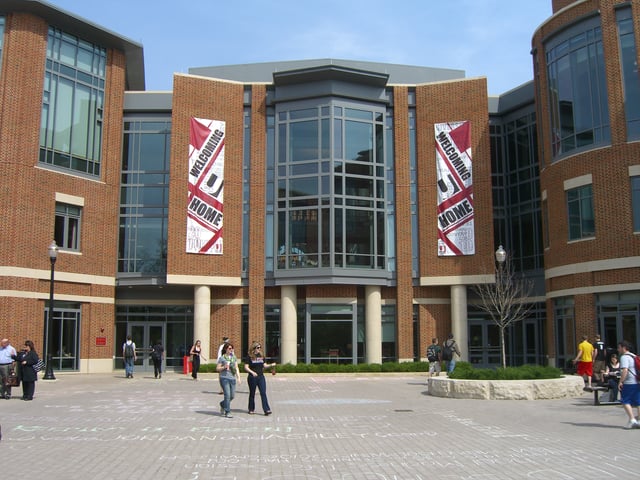
The Ohio Union
In 1916, Ohio State became the first university in Ohio to be extended membership into the Association of American Universities, and remains the only public university in Ohio among the organization's 60 members. The Public Ivies: America's Flagship Public Universities (2000) by Howard and Matthew Greene listed Ohio State as one of a select number of public universities offering the highest educational quality.
In its 2019 edition, U.S. News & World Report ranked Ohio State as tied for the 17th-best public university in the United States, and tied for 56th among all national universities.[23]
The Academic Ranking of World Universities placed Ohio State 42nd nationally and 79th globally for 2016. In its 2015-16 rankings, Times Higher Education World University Rankings ranked it tied for 90th in the world. In 2016, QS World University Rankings ranked the university 88th in the world.
The Washington Monthly college rankings, which seek to evaluate colleges' contributions to American society based on factors of social mobility, research, and service to the country by their graduates, in 2018 placed Ohio State 105th among national universities.
Ohio State is also the only public university in Ohio to which the Carnegie Foundation for the Advancement of Teaching has given both its highest overall classification of R1: Doctoral Universities – Highest Research Activity and highest undergraduate admissions classification of more selective.[24]
Bloomberg Businessweek ranked the undergraduate business program at Ohio State's Fisher College of Business as the 14th best in the nation in its 2016 rankings.[25] U.S. News & World Report ranks the MBA program tied for 30th in America.[23] Fisher's Executive MBA program was ranked 3rd nationally for return on investment by The Wall Street Journal in 2008 citing a 170 percent return on an average of $66,900 invested in tuition and expenses during the 18-month program.[26]
The history department was recently ranked 18th in the nation (6th among public universities) by the National Research Council.[27] The Ohio State linguistics department was recently ranked among the top 10 programs nationally, and top 20 internationally by QS World University Rankings.[28]
Ohio State is one of a select few American universities to offer multiple area studies programs under "Comprehensive National Resource Center" (often called "Title VI") funding from the U.S. Department of Education. The most notable of these is the Center for Slavic and East European Studies founded in 1965 by Professor Leon Twarog. Subsequently, Ohio State's Middle Eastern Studies Center and East Asian Studies Center also achieved Comprehensive National Resource Center status. The university is also home to the interdisciplinary Mershon Center for International Security Studies, which was founded in 1952 through a bequest of $7 million ($54.3 million in 2006 value) from alumnus Colonel Ralph D. Mershon. In 2003, the United States Department of Homeland Security decided to base the National Academic Consortium for Homeland Security at The Mershon Center.
Research
| OSU schools/colleges | |
|---|---|
| College of Dentistry | |
| College of Education and Human Ecology | |
| College of Engineering | |
| College of Food, Agricultural, and Environmental Sciences | |
| College of Medicine | |
| College of Nursing | |
| College of Optometry | |
| College of Pharmacy | |
| College of Public Health | |
| College of Social Work | |
| College of Veterinary Medicine | |
| College of Arts and Sciences | |
| Graduate School | |
| John Glenn College of Public Affairs | |
| Max M. Fisher College of Business | |
| Moritz College of Law | |
The Ohio State University is among the top 12 U.S. public research universities and 3rd among all universities in industry-sponsored research (National Science Foundation). [29] It is also named as one of the most innovative universities in the nation (U.S. News & World Report) and in the world (Reuters)).[29] In a 2007 report released by the National Science Foundation, Ohio State's research expenditures for 2006 were $652 million, placing it 7th among public universities and 11th overall, also ranking 3rd among all American universities for private industry sponsored research. Research expenditures at Ohio State were $720 million in 2007. In 2006, Ohio State announced it would designate at least $110 million of its research efforts to what it termed "fundamental concerns" such as research towards a cure for cancer, renewable energy sources and sustainable drinking water supplies.[30]
Research facilities include Aeronautical/Astronautical Research Laboratory, Byrd Polar Research Center, Center for Automotive Research (OSU CAR), Chadwick Arboretum, Biomedical Research Tower, Biological Sciences Building, CDME, Comprehensive Cancer Center, David Heart and Lung Research Institute, Electroscience Laboratory, Large Binocular Telescope (LBT, originally named the Columbus Project), Mershon Center for International Security Studies, Museum of Biological Diversity, National Center for the Middle Market, Stone Laboratory on Gibraltar Island, OH, Center for Urban and Regional Analysis and Ohio Agricultural Research and Development Center.
Big Ten Academic Alliance
Ohio State is a participant in the Big Ten Academic Alliance. The Big Ten Academic Alliance (BTAA) is the academic consortium of the universities in the Big Ten Conference. Engaging in $10 billion in research in 2014–2015, BTAA universities collaborate on various topics in medicine, technology, agriculture, and communities. Students at participating schools are also allowed "in-house" borrowing privileges at other schools' libraries.[31] The BTAA uses collective purchasing and licensing, and has saved member institutions $19 million to date.[32] Course sharing,[33] professional development programs,[34] study abroad and international collaborations,[35] and other initiatives are also part of the BTAA.
Admissions and tuition
| 2017 | 2016 | 2015 | 2014 | 2013 | 2012 | |
|---|---|---|---|---|---|---|
| Applicants | 52,427 | 49,388 | 45,919 | 42,791 | 35,475 | 28,675 |
| Admits | 22,939 | 24,240 | 22,500 | 22,679 | 19,511 | 18,352 |
| % Admitted | 43.8 | 49.1 | 49.0 | 53.0 | 55.5 | 64.0 |
| Enrolled | 7,136 | 7,885 | 6,978 | 7,024 | 7,083 | 7,186 |
Undergraduate admissions to Ohio State are classified as "more selective" by U.S. News & World Report and The Princeton Review and according to the data are the most selective for any public university in Ohio. 67% of incoming freshmen in autumn 2017 were ranked in the top 10% of their high school class. The average GPA at Ohio State is 3.81, the middle 50% range of ACT scores is 27-31 (average 29) , while the middle 50% SAT scores (Critical Reading and Math only) is 1260–1450 (average 1344)[43][44] Ohio State's freshman class has included at least 100 National Merit Scholars for nine of the last ten years.[45]
Tuition and fees for full-time, Ohio residents enrolled at the Columbus campus for the 2014–2015 academic year were $10,037.[46] For the 2006–2007 academic year, tuition at Ohio State for Ohio residents placed it as the fifth-most expensive public university and slightly beneath the weighted average tuition of $8,553 among Ohio's thirteen public four-year universities.[47] In addition to being named a Best in the Midwest selection by The Princeton Review, Ohio State was the only public university in Ohio to make their list of America's 150 Best Value Colleges.
Endowment and fundraising
Ohio State was among the first group[48] of four public universities to raise a $1 billion endowment when it passed the $1 billion mark in 1999. At the end of 2005, Ohio State's endowment stood at $1.73 billion, ranking it seventh among public universities and 27th among all American universities.[49] In June 2006, the endowment passed the $2 billion mark.
In recent decades, and in response to continually shrinking state funding, Ohio State has conducted two significant multi-year fundraising campaigns. The first concluded in 1987 and raised $460 million—a record at the time for a public university. The "Affirm Thy Friendship Campaign" took place between 1995 and 2000. With an initial goal of raising $850 million, the campaign's final tally was $1.23 billion, placing Ohio State among the small group of public universities to have successfully conducted a $1 billion campaign.[50] At his welcoming ceremony, returning President E. Gordon Gee announced, in the Fall of 2007, Ohio State would launch a $2.5 billion fund-raising campaign.
Student life
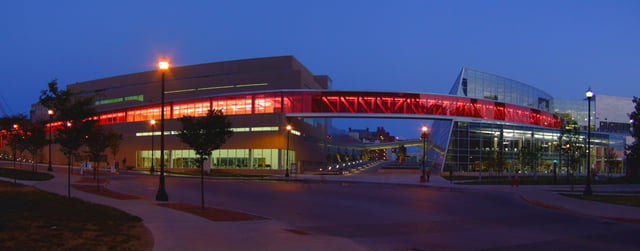
Recreation and Physical Activity Center (RPAC)
The Office of Student Life is responsible for many of the outside-the-classroom aspects of student life at Ohio State. It has more than 30 departments. Among these are student housing; dining services; health, wellness and counseling offices; the Ohio Union, student activities, organizations and leadership development; recreation and intramural sports. The Office of Student Life has partnership affiliations with the Schottenstein Center, the Blackwell Inn, and the Drake Events Center. Services supporting student wellness include the Wilce Student Health Center, named for university physician John Wilce, The Mary A. Daniels Student Wellness Center and the Counseling and Consultation Service and the Recreational and Physical Activity Center (RPAC).
The Office of Student Life also oversees the operation of the RPAC. The RPAC is the main recreational facility on campus and offers over half a million square feet of recreation, aquatic, fitness, and meeting space. The RPAC features two on-campus dining locations, a 50-meter competitive pool, 12 wood courts, 10 racquetball courts, 4 squash courts, a four-lane jogging/walking track, five multipurpose rooms, and 27,500 square feet of fitness space. is also inside of the RPAC. The Wellness Center within the RPAC offers services such as nutrition counseling, financial coaching, HIV and STI testing, sexual assault services, and alcohol and other drug education.[51] The Outdoor Adventure Center (OAC) is another recreational facility on campus. The OAC features the Tom W. Davis Climbing Center with a 4,000-square-foot, 35-foot tall climbing structure and bouldering cave. The OAC also has an outdoor equipment rental office and a trip-planning resource center. [52] Wireless access throughout the campus, with over 12,000 access points spread through the campus.
Ohio State's "Buckeye Bullet" electric car broke the world record for the fastest speed by an electric vehicle on October 3, 2004, with a speed of 271.737 mph (437.3 km/h) at the Bonneville Salt Flats in Utah.[53] The vehicle also holds the U.S. record for fastest electric vehicle with a speed of 314.958 mph (506.9 km/h), and peak timed mile speed of 321.834 mph (517.9 km/h). A team of engineering students from the university's "Center for Automotive Research-Intelligent Transportation" (CAR-IT) designed, built and managed the vehicle. In 2007, Buckeye Bullet 2 was launched. This follow-up effort was a collaboration between Ohio State engineering students and engineers from the Ford Motor Company and will seek to break the land speed record for hydrogen cell powered vehicles.[54]
A unique aspect to Ohio State's multibillion-dollar endowment is the Student Investment Management Program. Upperclass finance students taking Business Finance 724 are given the opportunity to manage a twenty million dollar investment fund. Returns from the student-managed funds often outperform the S&P 500 and frequently even the university's own professional fund managers.[55]
Jon Stewart hosted The Daily Show's "Battlefield Ohio: *The Daily Show'*s Midwest Midterm Midtacular" from Ohio State's Roy Bowen Theatre during the week of October 30 to November 2, 2006.[56]
Music
The marching band is also a longstanding tradition at Ohio State. It is the largest all-brass and percussion band in the world. The traditional school songs, which include "Carmen Ohio", "Hang on Sloopy", and "Fight the Team Across the Field", are arranged to fit this instrumentation. The band is famous for "Script Ohio", during which the band marches single-file through the curves of the word "Ohio", much like a pen writes the word, all while playing the French march "Le Regiment de Sambre et Meuse." At the end of the performance, a high-stepping senior sousaphone player "dots" the "i" in Ohio.
"Across the Field", Ohio State's fight song, and "Buckeye Battle Cry" are commonly played and sung at athletic events, as well as commencement and convocation exercises.
OSU's School of Music contains several high-quality concert bands made up of graduate and undergraduate music majors and non-music majors. The OSU Wind Symphony often receives praise on the national level and was selected to perform at the 2003 College Band Directors National Association (CBDNA) Convention and at the Ohio Music Educators Association Conference in 2001, 2004, 2006, and 2008; the OSU Symphonic Band performed in 2007. The OSU Wind Symphony released its newest album, Southern Harmony, on the Naxos Label in 2009. The Ohio State Jazz Ensemble performed at the Montreux Jazz Festival in 1975, 1978, 1986, 1996, and 2001. It also appeared at the Mexico City International Jazz Festival in 1990 and the North Sea Jazz Festival in 1986, 1996, and 2001. There is also an OSU Symphony Orchestra.
In addition to strong bands, the university is recognized for outstanding choral performance. The Ohio State University Men's Glee Club was formed in 1875.[57] In 1990, led by Professor James Gallagher, the Men's Glee Club participated in the International Musical Eisteddfod in Llangollen, Wales, and won the male chorus competition by an unprecedented 20 points before, in a unanimous decision of the judges, being named "Choir of the World"—the first American choir to win such an honor. Robert J. Ward directs the Glee Club. The Ohio State Women's Glee Club was established in 1903.[58] In the group's recent past, under the leadership of Dr. Hilary Apfelstadt, the Glee Club has been selected to sing for state and regional conferences of the Ohio Music Education Association and the American Choral Directors Association. Beginning its season under the direction of Dr. Richard Schnipke, the OSU Women's Glee Club was honored to sing for the Ohio Choral Directors Association annual conference in June 2010.
Sexual harassment handling
In June 2018, The Ohio State dissolved its Sexual Civility and Empowerment unit and eliminated four positions in the unit due to concerns about mismanagement and a lack of support for survivors of sexual assault.[59] This occurred after the unit was suspended in February 2018 and following an external review.[60] The Columbus Dispatch and the school newspaper, The Lantern reported that "[SCE] failed to properly report students' sexual-assault complaints" and that some victims were told that they were "'lying', 'delusional', 'suffering from mental illness', 'have an active imagination', that they 'didn't understand their own experience' and also 'fabricated their story'."[61][62] With help from the Philadelphia law firm Cozen O'Connor, the university will be creating a new framework to handle sexual assault cases and reevaluating its Title IX program.
On July 20, 2018, BBC News reported that over male 100 students, including athletes from 14 sports, had reported sexual misconduct by a deceased university team physician, Richard Strauss.[63] The reports dated back to 1978 and included claims that he groped and took nude photographs of his patients. Four former wrestlers filed a lawsuit against Ohio State for ignoring complaints of "rampant sexual misconduct" by Strauss. U.S. Representative Jim Jordan was named in the lawsuit and has since denied the former wrestlers' claims that he knew about the abuse while he was an assistant coach for eight years at the university.[64] The investigation is ongoing.
Diversity
Ohio State's main campus has been lauded for the racial diversity of its student body. In various surveys and rankings, it has been included among the best campuses in the nation for African Americans. Ohio State ranked 10th in the nation in 2006 for the numbers of African American doctors graduated. The Advocate College Guide for LGBT Students lists Ohio State as one of the 20 best campuses in America for LGBT students.[65] One campus feature that helps aid student diversity is the Multicultural Center.
Ohio State, despite selective admissions, has also maintained a high amount of socio-economic diversity among its students. The 2007 freshman class contained 22.7% of first-generation college students, which far exceeded the national norm on American campuses of 15.9%.[66]
University housing

South Campus Gateway
Ohio State operates 38 on-campus residence halls divided into three geographic clusters: South Campus (site of the university's original dormitories) (currently include joint dorms known as Smith-Steeb and Park-Stradley), North Campus (largely constructed during the post-war enrollment boom) and West Campus or "The Towers". The residence hall system has 40 smaller living and learning environments defined by social or academic considerations. Ohio State also offers three honors residence halls: Bradley Hall, Lincoln Tower, and Taylor Tower.
Separate housing for graduate and professional students is maintained on the Southern tier of campus within the Gateway Residential Complex and the William H. Hall Student Residential Complex. Family housing is maintained at Buckeye Village at the far northern edge of campus beyond the athletic complex.
Student Life University Housing also administers student residential housing on the OSU Newark, OSU Mansfield, and OSU Agricultural Technical Institute (ATI) campuses.
The Residence Hall Advisory Council (RHAC), which is a representative body of all students living in the University's residence halls, helps evaluate and improve the living conditions of the residence halls.[67]
Honors programs
Ohio State offers two distinct honors programs for high ability undergraduates: Honors and Scholars. The Honors program is open to students in all majors. The Scholars program is centered on thirteen specific programs such as "Architecture Scholars", "Media, Marketing, and Communications Scholars", "Biological Sciences Scholars", "International Affairs Scholars", "Business Scholars" and "Politics, Society and Law Scholars." Students in the Scholars program are expected to live and take select classes with other members of the program. Additionally, Ohio State offers the Honors Collegium with membership extended to ten incoming freshmen and following the Spring of a student's first or second year to the university's top undergraduates. Collegium students try to compete for internships, graduate schools and nationally competitive awards, such as the Marshall, Rhodes, or Truman Scholarships.
Ohio State also administers two large-scale scholarship programs to ensure access to the university to high-ability students from low-income or traditionally underrepresented groups. The first, The Young Scholars Program, was initiated in 1988. 120 promising minority students from Ohio's nine largest urban public school districts are selected prior to entering high school. The program offers a series of academic camps each summer and counseling throughout the students' high school careers. Upon completion of the program, which also mandates a college preparatory curriculum and minimum grade point average, the students are guaranteed admission to Ohio State as well as any need-based financial aid. The Land Grant Scholarship was initiated in 2005. This program seeks to ensure access to Ohio State to high-ability students from low-income backgrounds. Ohio State has committed to offering a full-ride scholarship each academic year to at least one student from each of Ohio's 88 counties.
Ohio State maintains an honors center in the Kuhn Honors and Scholars House, which served as the University President's residence until the 1960s. Three residences are designated all or in part as honors residences: Taylor Tower, Bradley Hall, and Lincoln House.
Activities and organizations
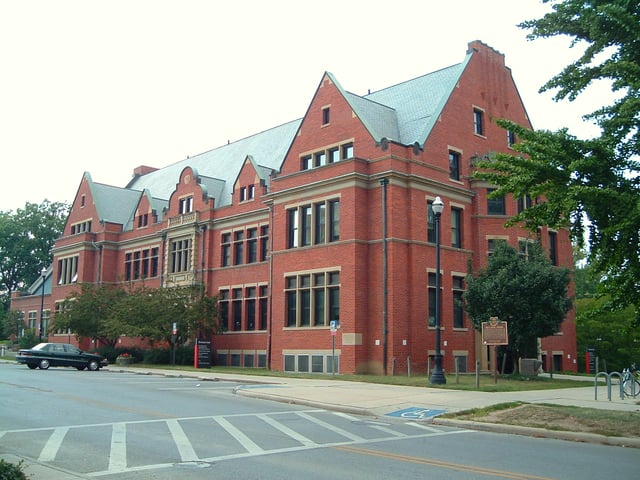
Hale Hall (Original Ohio Union)
Ohio State is rated at the #3 most amazing student union (Best College Reviews).[29] The Ohio Union was the first student union built by an American public university. The Ohio Union is dedicated to the enrichment of the student experience, on and off the university campus. The first Ohio Union, on the south edge of the South Oval, was constructed in 1909 and was later renamed Enarson Hall. The second Ohio Union was completed in 1950 and was prominently along High Street, southeast of the Oval. It was a center of student life for more than 50 years, providing facilities for student activities, organizations and events and serving as an important meeting place for campus and community interaction. The union also housed many student services and programs, along with dining and recreational facilities. The second Ohio Union was demolished in February 2007 to make way for the new Ohio Union, which was finished in 2010. During this time, student activities were relocated to Ohio Stadium and other academic buildings.[69]
Student organizations
Student organizations at Ohio State provide students with opportunities to get involved in a wide variety of interest areas including academic, social, religious, artistic, service-based, diversity and many more. There are over 1,000 registered student organizations that involve many thousands of students.[70] The university's forensics team has won the state National Forensics Association tournament several times.[71]
Block "O" is currently the largest student-run organization on the campus of Ohio State. With over 2,400 annual members, Block "O" serves as the official student cheering section at athletic events for the University. According to the Student Organization Office in the Ohio Union, Agricultural Education Society is the oldest student organization on campus. The Men's Glee Club often disputes the claim, but after consultation with Ohio Union Staff, Agricultural Education Society was named as the university's oldest organization.
Each year, students may sign-up to participate in BuckeyeThon [105] , Ohio State's student-led philanthropy. The organization hosts events throughout the year to support the hematology/oncology/bone marrow transplant unit[72] at Nationwide Children's Hospital in Columbus, Ohio. Although BuckeyeThon is operated entirely by student volunteers, it is embedded within Student Life and the Ohio State University Foundation.[73] The organization receives support, advising, and specialized leadership training from the University. Each February, thousands of students and community members attend BuckeyeThon's signature event, a Dance Marathon consisting of two separate 12-hour shifts. In the past 15 years, students have raised over $5 million to support treatment, research, and various therapies at the hospital.[74] Unique to BuckeyeThon is the use of an operational fund separate from the main philanthropic cancer fund. As a registered non-profit, BuckeyeThon is subject to University audit and issues gift receipts through the Foundation.[75] An annual operational fund relies on University grants, outside sponsors, and event registration fees. This allows the entirety of donations made to the cancer fund to solely support patients without hindrance from outside costs.
Ohio State has several student-managed publications and media outlets. The Makio is the official yearbook.[76] The Makio's sales plummeted by 60% during the early 1970s; the organization went bankrupt and stopped publication during the late 1970s. The book was revived from 1985 to 1994 and revived again in 2000 thanks to several student organizations. The Lantern is the school's daily newspaper and has operated as a laboratory newspaper in the School of Communication (formerly the School of Journalism) since 1881. Mosaic is a literary magazine published by Ohio State, which features undergraduate fiction, poetry, and art. The Sundial is a student-written and published humor magazine. Founded in 1911 it is one of the oldest humor magazines in the country. After a 17-year hiatus in which no magazine was published it has recently been revived, first in print form, and now in an online humor blog, as well as multiple social media outlets.[77][78] Ohio State has two improvisational comedy groups, The 8th Floor Improv and Fishbowl Improv, who regularly perform long and short-form improv around campus and across the U.S.[79][80] There are two student-run radio stations on campus. AROUSE, the music station, is home to over 100 student DJs, streaming music and independent content.[81] Scarlet and Gray Sports Radio broadcasts eleven different Ohio State sports.[82] Both stations broadcast on an Internet audio stream (no broadcast signals are available in Columbus). Students also operate a local cable TV channel known as Buckeye TV, which airs primarily on the campus closed cable system operated by the Office of the Chief Information Officer (OCIO).
Leadership and service
The Union's vision is to prepare students to be responsible, engaged leaders committed to community participation for social action and change. Programs with which students can get involved include are the Leadership Collaborative, Leadership Ohio State, Residence Halls Advisory Council, LeaderShape, Buckeye Service Council, Community Commitment Day, SERV team, Service Squad, ImpactOSU, and BUCK I SERV alternative break trips. Additionally, the Service-Learning Institute offers courses that educate students while also helping the greater community. All of these programs have the ultimate goal of making students better leaders, people, and citizens of Ohio.[83]
In 1914, with the approval of President William Oxley Thompson and under the watchful eye of Dean Caroline Breyfogle, Ph.D., Mortar Board Senior Honor Society was established by seven senior women. Four years later, the members of the group then became one of the four founding chapters of Mortar Board National College Senior Honor Society, which now has charters at 231 campuses in the U.S. For more than 100 years at Ohio State, members of Mortar Board have been selected for their significant contributions in scholarship, leadership and service.
Student government
At The Ohio State University, three recognized student governments represent their constituents.[84]
Undergraduate Student Government (USG), which consists of elected and appointed student representatives who serve as liaisons from the undergraduate student body to university officials. USG seeks to outreach to and work for the students at Ohio State.
Council of Graduate Students (CGS), which promotes and provides academic, administrative, and social programs for the university community in general and for graduate students in particular. The Council provides a forum in which the graduate student body may present, discuss, and set upon issues related to its role in the academic and non-academic aspects of the University community.
Inter-Professional Council (IPC), which is a representative body of all professional students in the colleges of Dentistry, Law, Medicine, Optometry, Pharmacy, and Veterinary Medicine. Its purpose is to act as a liaison between these students and the governing bodies of the University.
Athletics

OSU Athletics logo
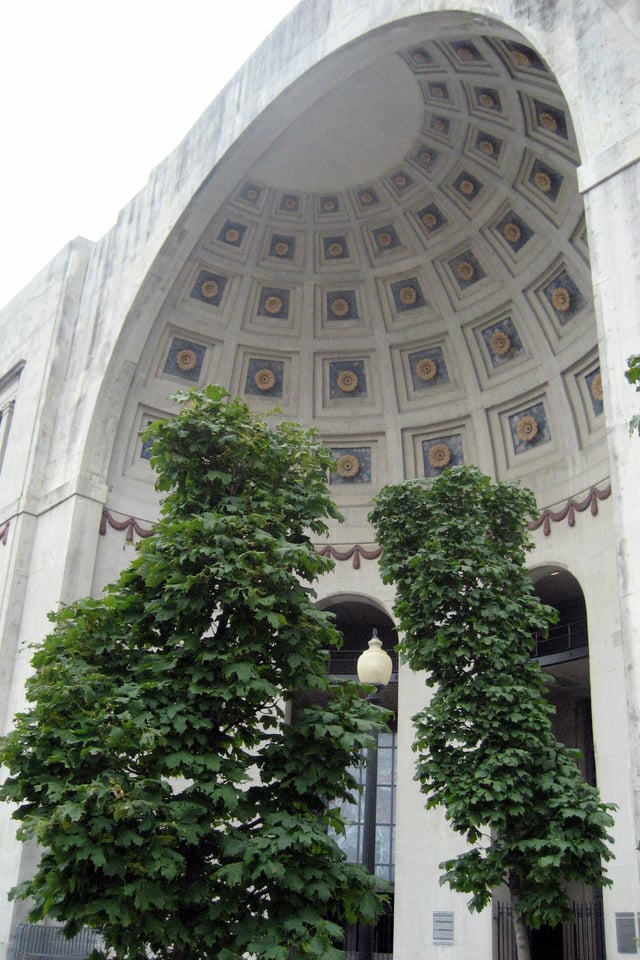
Ohio Stadium Rotunda
Ohio State's intercollegiate sports teams are called the "Buckeyes" (derived from the colloquial term for people from the state of Ohio and after the state tree, the Ohio Buckeye, Aesculus glabra),[85] and participate in the NCAA's Division I in all sports (Division I FBS in football) and the Big Ten Conference in most sports. (The women's hockey program competes in the Western Collegiate Hockey Association). The school colors are scarlet and gray. Brutus Buckeye is the mascot. Ohio State currently has 36 varsity teams.
Ohio State is one of six universities (the University of Michigan, the University of Florida, Stanford University, UCLA, and the University of California at Berkeley being the others) to have won national championships in all three major men's sports (baseball, men's basketball, and football).[86] Ohio State is also one of only two universities to appear in the national championship games in both football and men's basketball in the same calendar year (the other university is the University of Florida.) Ohio State has also won national championships in wrestling, men's volleyball, men's swimming & diving, men's outdoor track & field, men's golf, men's gymnastics, men's fencing, women's rowing, co-ed fencing, and multiple synchronized swimming championships.[87] The Ohio State equestrian team has won eight Intercollegiate Horse Show Association national championships.[88] Since the inception of the Athletic Director's Cup, Ohio State has finished in the top 25 each year, including top 6 finishes in three of the last five years.[89] During the 2005–2006 school year Ohio State became the first Big Ten team to win conference championships in Football, Men's Basketball, and Women's Basketball. Ohio State repeated the feat during the 2006–2007 school year, winning solo championships in all three sports. In 2007, Sports Illustrated nicknamed Ohio State's athletic program as being "The Program" due to the unsurpassed facilities, an unparalleled number of men's and women's sports teams, their success, and the financial support of an impressive fan base.[90]
Outstanding sports figures that were student athletes at Ohio State include 1936 Olympics gold medalist Jesse Owens "the Buckeye Bullet" (track and field), John Havlicek, Jerry Lucas, Bobby Knight, and Larry Siegfried (basketball), 2010 Olympics silver medalist Ryan Kesler (ice hockey), Katie Smith and the first 3-time player of the year in Big Ten Basketball history Jessica Davenport (women's basketball), Frank Howard (basketball and baseball), Jack Nicklaus (golf); and Chic Harley (three-time All-American football running back). Ohio State football players have combined for seven Heisman Awards including the only two-time winner Archie Griffin in 1974 and 1975, Eddie George in 1995, and most recently Troy Smith in 2006. Hall of Fame coaches at Ohio State have included Paul Brown, Woody Hayes, and Jim Tressel in football, Fred Taylor in basketball, Larry Snyder in track and field, and Mike Peppe in swimming and diving. Hall of fame players, in pro-football, include Sid Gillman, Lou Groza, Dante Lavelli, Jim Parker, Paul Warfield, Dick LeBeau, and Bill Willis.
Affiliated media
Ohio State operates a public television station, WOSU-TV (virtual channel 34/DT 38, a local PBS TV station), as well as two public radio stations, WOSU-FM 89.7(NPR/BBC news/talk) and WOSA-FM 101.1 (classical, "Classical 101") in Columbus.
People
Faculty
Ohio State's faculty currently includes 21 members of the National Academy of Sciences or National Academy of Engineering, four members of the Institute of Medicine,[91] and 177 elected fellows of the American Association for the Advancement of Science. In 2009, 17 Ohio State faculty were elected as AAAS Fellows. Each year since 2002, Ohio State has either led or been second among all American universities in the number of their faculty elected as fellows to the AAAS.[92][93]
In surveys conducted in 2005 and 2006 by the Collaborative on Academic Careers in Higher Education (COACHE), Ohio State was rated as "exemplary" in four of the seven measured aspects of workplace satisfaction for junior faculty at 31 universities: overall tenure practices, policy effectiveness, compensation, and work-family balance.[94]
In the last quarter century, 32 Ohio State faculty members have received the prestigious Guggenheim Fellowship, which is more than all other public and private Ohio universities combined. In 2008, three Ohio State faculty were awarded Guggenheim Fellowships, placing Ohio State among the top 15 universities in the United States.[95] Since the 2000–2001 award year, 55 Ohio State faculty members have been named as Fulbright Fellows, the highest of any Ohio university.[96]
Alumni
Ohio State has over 475,000 living alumni around the world.[97] Ohio State alumni include Nobel Prize recipients, Pulitzer Prize recipients, Olympic Games gold medalists, and Medal of Honor recipients, ambassadors, as well as Fortune 500 CEOs and members of the Forbes 400 list of the world's wealthiest individuals. Numerous graduates have gone on to become U.S. governors, senators and members of Congress. Ohio State alumni have appeared on the cover of Time magazine twelve times, with the artwork of alumnus Roy Lichtenstein featured on an additional two Time covers. George Steinbrenner, former owner of the New York Yankees who won seven World Series with the team, earned his master's degree from Ohio State. Larry Sanger, One of the founders of Wikipedia, and Steve May, Chief Technology Officer at Pixar, both graduated from Ohio State. Roboticist James S. Albus was named a "Hero of US Manufacturing" by Fortune Magazine in 1997.[98]
Ohio State alumni have been inducted into the Baseball Hall of Fame in Cooperstown, New York, the NFL Hall of Fame and the Basketball Hall of Fame. Its athletes have won a combined eighty-three Olympic medals and three times have received the Sullivan Award as the nation's top amateur athlete. Jack Nicklaus has been called "the greatest golfer in history", and Jesse Owens has been called "the greatest Olympian in history". Twice, Ohio State alumni have appeared on the cover of Sports Illustrated as its Sportsman of the Year.
See also
Jack Nicklaus Museum
List of buildings at Ohio State University